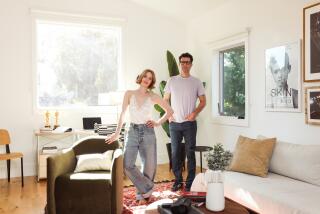Home Improvement : Second-Story Addition Doubles the Space : Culver City couple uses Japanese touches in complete reshaping of conventional house.
When the mayor of Culver City greets you at her front door, thereâs a slight hesitation as she asks you to remove your shoes.
âItâs a new ritual with our family,â explained Jozelle Smith, eager to show off her newly remodeled, Japanese-themed home located in the prime residential area of Culver Crest.
For the record:
12:00 a.m. Oct. 15, 1989 For the Record
Los Angeles Times Sunday October 15, 1989 Home Edition Real Estate Part K Page 4 Column 6 Real Estate Desk 1 inches; 29 words Type of Material: Correction
Remodeling--In the Oct. 1 remodel story on the home of Ken and Jozelle Smith, architect Tom Whitlock was mentioned as founding partner of Eagle Group, Culver City. The founding partner is Bill Silvestre.
âI donât know how much longer Iâll be able to get away with it,â she smiles, âbut it does fit in with our life style.â
With a second-floor addition that has almost doubled their living space, Japanese touches are now an integral part of the Smithsâ home. In stocking feet, the visitor experiences a pleasant sensory transition--from the coolness of the slate-surfaced entry to the nubbiness of Berber carpeting, to the satiny feel of polished hardwood floors.
Shoji Screens
A visual treat is the expanse of high, varnished wooden ceilings, the grid pattern of shoji screens and a colorful Japanese ceremonial kimono spread against the stark white stucco wall. Above it, sparkling glass-block balconies define large openings that function as interior clerestories for the light entering from skylights.
Until a month ago, during a remodeling period that lasted almost a year, Ken and Jozelle Smith had been living like gypsies, in temporary quarters in a closed-off corner of the four-bedroom house.
âFrom time to time we would emerge, like moles, into this cavernous space to witness the shaping of our new home,â the mayor said.
With professional guidance from Thomas Whitlock, a local architect and founding partner of the Eagle Group, the Smiths transformed a 2,500-square-foot single-story house into a striking two-story âCalifornia eclecticâ that grew to 4,700 square feet.
Enticing Options
âOur initial plan was simply to add a second-story master bedroom suite to a house that already had an adequate floor plan,â Ken Smith said. âTom (Whitlock) came up with two enticing options for the second floor addition--one to be built over the garage, the other above the central portion of the house.â
The Smiths liked both versions and the result was a splicing of the best of each scheme to create maximum utilization of a spectacular 180-degree view that took in all of Century City and Beverly Hills, down to Playa del Rey.
Their new second level houses a spacious master bedroom suite, an office for Ken Smith, a family room, two extra baths, two balconies and a large storage area.
The estimated cost of the Smithsâ remodel is about $300,000.
House Was Gutted
To accommodate the new design, the house was gutted to its bare walls and the foundation strengthened in areas where new load-bearing columns were required. âBut, basically, we followed the original footprint of the house,â Whitlock said.
The Smiths had a pretty clear idea of what they wanted in a home. Both are tall and wanted high ceilings in a house that was airy, informal and designed to reflect a subtle Oriental theme.
âOur interest in the Japanese culture stems from a close relationship with the people of Kaizuka--our sister city in Japan--both officially, during my tenure as City Council member, and as a family. We have a Japanese daughter-in-law and a grandson, Shotaro, who is Japanese-American.â
Deferential to Art
For Whitlock the primary challenge was to shape a house that was capable of asserting its own architectural identity while remaining properly deferential to the choice art pieces the Smiths had collected during their travels.
âThe house performs a sort of architectural striptease. It only gradually reveals its parts and places,â Whitlock explained.
âIt was a happy coincidence when we learned that Tom was a serious student of Japanese design and had previously designed an authentic Japanese home on the Westside,â the mayor noted.
For the Smiths, rather than design a literal copy of a Japanese house--which would demand a life style quite unlike theirs, Whitlock stole some Oriental architectural concepts and used a lot of input from Ken and Jozelle Smith.
A Sweeping View
âI always thought the way to take advantage of a sweeping view from a second story was by installing solid glass walls,â Ken Smith noted. âBut Tom pointed out that having too much of a good thing could be boring. He suggested a characteristically Japanese architectural approach that was very appealing.â
Instead of throwing up a glass wall against the view, Whitlock proposed a selective placement of smaller windows by which certain portions of the sweeping view could be edited, cropped, framed and intensified.
Adding a second story to any house is not something you do without a lot of planning and professional assistance, the Smiths cautioned.
âWe learned that a vertical addition is always more expensive than a horizontal expansion and is never simple. It shouldnât be attempted without the help of an architect. A professional can actually save you additional construction costs through proper planning and engineering,â Ken Smith believes.
Costs increase, according to the architect, when existing bathrooms require rerouting for vents, when air-conditioning ducts have to be repositioned, or foundations have to be reinforced.
Whitlock estimates that a second-story addition costs 40% more than an addition at grade level.
WHEN TO CONSIDER ADDING A SECOND STORY
Architect Thomas Whitlockâs recommendations:
When the lot area available for expansion at grade is limited. This limit may be imposed by unfavorable terrain, zoning code restrictions, lot size or simply the ownerâs desire to retain as much outdoor space as possible.
To gain a special view not otherwise available from the first floor. You may consider turning the traditional house on its head by putting the main living areas upstairs, with the bedrooms downstairs.
To escape from the confinement of an eight-foot ceiling. Rooms can be opened up vertically with high ceilings, balconies, bridges and overlooks. The real dimension of vertical space is enriched by the psychological dimension of âabove.â
IF YOU DECIDE TO TACKLE AN ADDITION
Once you have decided to build a second-story addition, architect Thomas Whitlock suggests you:
Hire an architect, preferably one with experience in residential additions. In the long run, you will save time and money and you will have a home that functions well, with an addition that is an integral part of the existing structure.
Work with your architect to get just what you want at a price that will keep you and your checkbook on speaking terms. There are shortcuts to this process but the fruit they bear are generally eyesores.
Be prepared to move yourself and your possessions to different quarters for a while. A construction site is a messy, noisy place and living in the middle of one can test the best marriages. Be prepared for intermittent periods without water, gas and electricity.
More to Read
Sign up for Essential California
The most important California stories and recommendations in your inbox every morning.
You may occasionally receive promotional content from the Los Angeles Times.






